#let dahaka
Text

Hero's
#inu's bday jams#hero's#mashima hero's#hiro mashima#let dahaka#rm julia#julia line dragoon#natsu dragneel#shiki granbell#fantasy#adventure#crossover#manga
12 notes
·
View notes
Text

2013.05.20: 滑川さん誕生日おめでとう!FTxRAVEでジュリアを演じてもらいました。@/namekyon
Happy Birthday Namekawa-san! You played Julia in FTxRAVE. [CV: Kyouko Namekawa] (DeepL Translate)
10 notes
·
View notes
Text

“Julia. It’s a pleasure.”
#ibispaint art#my artwork#sketch#ibispaint my beloved#ibispaintx#rave master#hiro mashima#fairy tail#edens zero#julia#let dahaka#original art#manga#manga coloring#anime fanart#anime guy#anime woman
12 notes
·
View notes
Text
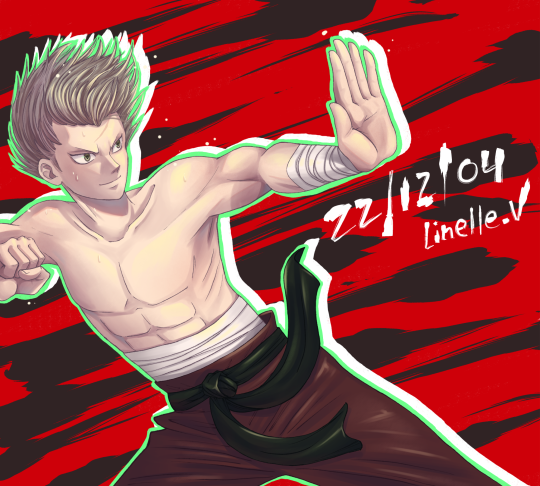
12/04 - Let Dahaka's birthday🐉
9 notes
·
View notes
Text
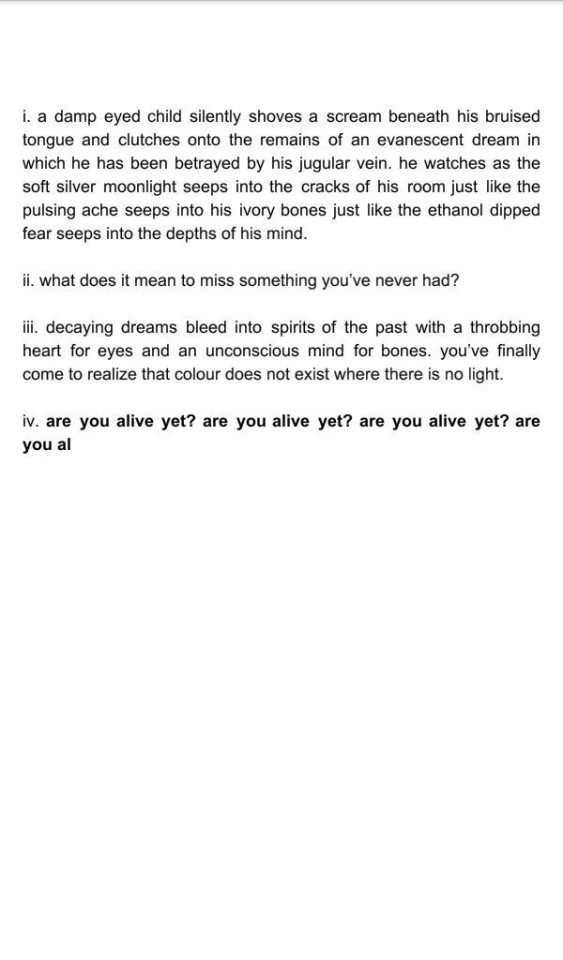
@wingsofatonement
@cpirits
#muse inspo#sofia sakharov#*this feels like what she sees Kyoya as#honestly i feel that Kyoya is a lot more fragile than he thinks#than he realises#than he lets himself be#Kyoya is small and unworthy and Azi Dahaka is always doubting him#it's in Azi Dahaka's support cards text#he ruminates over and over again about whether Kyoya is strong enough#in the end they are halves of each other#and they both force themselves forward#which is why they broke in triple d#and i know it seems like Kyoya was on a bus in season 3#but i like to think of it as taking time for himself and his buddy to heal....#perhaps together....#rouga didn't need any healing HAHA#he's just GOGOGOGO#all the time#every time#he gets over things quick#tagging people whose muses i mentioned in these tags#hope that's ok
1 note
·
View note
Note
I'm curious abut Sascha Vykos. Do you know which novels or splat books would be good to read to learn more about them?
*cracks knuckles*
Number 1 book you need to understand Sascha's background is the Dark Ages Tzimisce clan novel by Myranda Kalis, which has them as the main character (along with their lover, Ilias cel Frumos) and explains why they're... like that. Just a goddamn amazing character study, also completely heartbreaking and singlehandedly made me change my view of them from "haha wtf what an edgelord" to "they're my baby and I'm gonna fight a methuselah for them". Set between 1232 and 1234, if I've managed to maths right.
Also by Myranda and set around a similar time (shortly after the fall of Constantinople) is the Road of Sin book (set around 1205). Sascha (then called Myca) narrates the introduction and first chapter. It does specifically focus on their history with the eponymous Road, but has a lot of interesting character details, along with their relationship with Ilias.
For modern Sascha, there are two. First is the original Clan Novel Saga (set 1999), although in this case, I'm not recommending just the Tzimisce novel, but rather the compiled editions. There's a bunch of Sascha content in the Assamite book as well, since they're quite involved with one of the characters in it, and it also includes extra, exclusive content, including my two favourite chapters - a story by Lucien Soulban (Sascha's creator), and an epilogue by Janet Trautvetter, mostly about Jan Pieterzoon but with Sascha being fairly prominent in it.
Fair warning, CNS was written in 1999 and has. Mm. Edgelordy moments. We do not talk about The Foetus Thing :|
The other, probably most important one is Beckett's Jyhad Diary, which I would recommend for literally anyone interested in VtM in general. Sascha has minor appearances and mentions in a bunch of chapters, but is extremely prominent in the chapter Dreams & Nightmares (also by Myranda Kalis/Sarro). She also wrote the chapter Azhi Dahaka, another must-read relating to Sascha.
The timing for BJD is... less clear, because at least a few of the people involved have said it's set in 2005, but also there's one chapter where an event that explicitly took place around 1999 or 2000 is said to have taken place "sixteen years ago", so. Let's just call that early 21st century.
Most of the rest of the books are chronicles, plus one city book - their origin book, Constantinople by Night (1197, IIRC?) by Lucien Soulban, Philippe Boulle, and Joshua Mosqueira-Asheim. Others, in chronological order by setting, include Bitter Crusade (two chapters, Fiendish Winter and Dying Embers, the latter covering the Fall of Constantinople in 1204), Under the Black Cross (1225), and a whole bunch of the Transylvania Chronicles (Myca/Sascha appears in book 1 in Dark Tides Cresting (1314), in book 2 in Haceldema (covers the Convention of Thorns, 1493), in book 3 in An Angel's Plea (1680, also has the most hilariously thirsty description of Sascha I've ever seen in my life), and in book 4 in The Accounting (1998).)
Seriously. Here's their Transylvania Chronicles 3 character sheet:
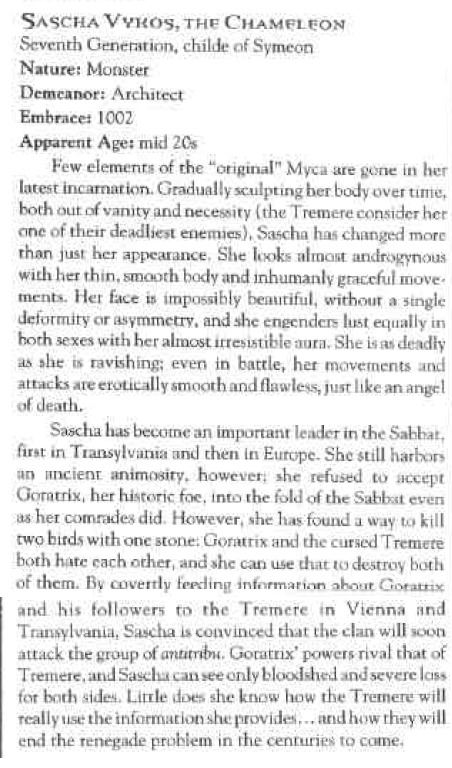
They appear in two of the Giovanni Chronicles books, three (1882) and four (same, in a flashback that also has my baby Anatole), in the Nightshade scenario of the Gehenna book (1999), although that's since been retconned out of existence, along with chunks of the Clan Novel Saga, mostly to do with the approaching Gehenna stuff, and in particular Anatole's fate. It's still worth reading just for some fascinating ways the world could end. Finally, they appear in the House of Lies chapter of Nights of Prophecy (1999?).
Aside from those, they also have little appearances and mentions in other books, including letters and notes throughout chapter 7 of the Revised corebook, a rather amusing little reference in chapter 4 of the Victorian Age corebook, a detailed profile and character sheet in Children of the Night although that book pisses me off because it put Beckett, Anatole, and Lucita on the front cover but didn't give us sheets for them!, and the opening letter of the V5 Sabbat book, which you can read here (and then ignore the rest of the book and get the Revised-era Guide to the Sabbat instead).
So yes! They show up a lot, and all through the game's history. The three most important ones to read, I think, are the Dark Ages Tzimisce novel, the combined Clan Novel Saga, and Beckett's Jyhad Diary, then the rest just depending on interest in the era or broader story, since Sascha is less involved in those.
Have fun! They're an absolute hot mess of a character and I adore them!
34 notes
·
View notes
Text
I know the description mentioned the Tower of Babil again, so are we just going to do the whole schtick where MC is trapped inside Yuji and just watching everything again? That's lame if true. Let MC do some shenanigans. I want them to walk around Yggdrasil while everyone stares in shock and horror because what the hell they thought Freyr was dead.
Oh cool, Loki is going to be in the event. Maybe he'll actually elaborate on what happened with Freyr just fucking off from existence while everyone else was brought back after Ragnarok.
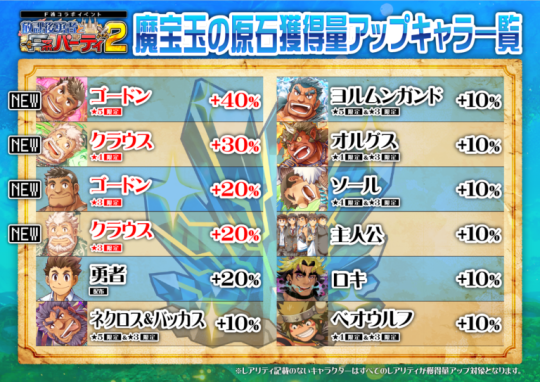

Fafnir's research file mentioned that he and Tiamat share the ability to combine and divide dragon veins.

Gordon is just some dude except he's not.
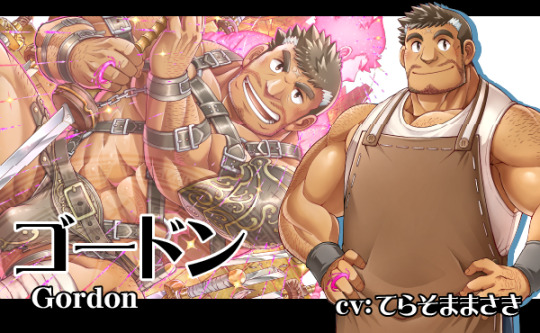
Claus' research file mentions the version of Ahriman from F-Kare. His brother was "possessed" by Ahriman and he still has the body of a child, but oddly his "spiritual" form that appears with Claus in his 4* art has the body of an adult.
Some of y'all were worried about Ahriman being a shota due to his F-Kare version, so I'll say that it sounds more like Ahriman just picked someone to possess so that he could interact with the physical realm like he did with Azi Dahaka in Garo Demana and it's not a representation of his true form.
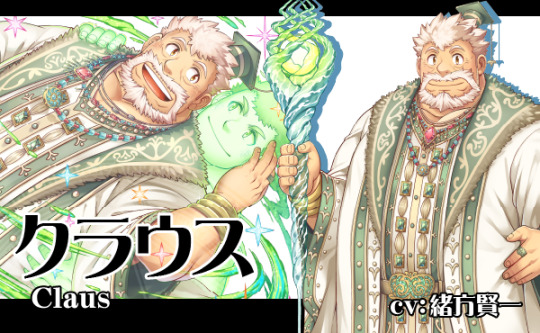
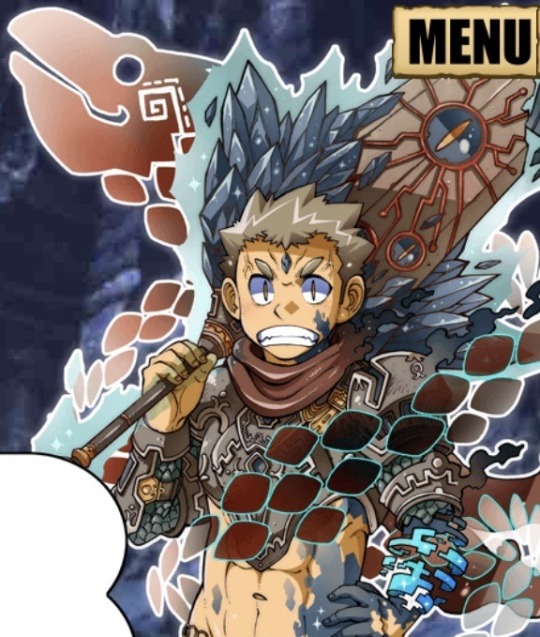
Event banners

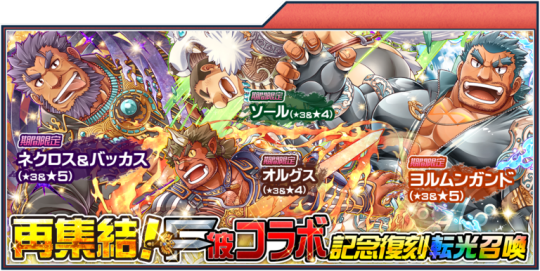
Some of the AR cards. One didn't load for me for whatever reason.
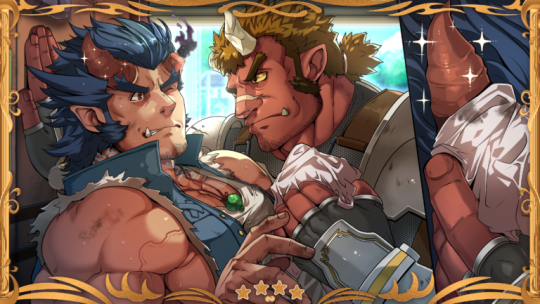

40 notes
·
View notes
Text

"I...I don't know."
I was so busy making sure that nobody knew I wasn't Kyoya that I never thought about my life before I got here. Why do I remember stuff like Yu-Gi-Oh, Sailor Moon, geography, and history but nothing about me?
Did I have any family, friends, in fact how did I even got here in the first place?
Azi Dahaka stares at the child before him, her face filled with confusion and despaired as she starts to ignore her surrounding and lose herself in her thoughts. As he stares, he noticed a very familiar light inside of her.
"Ah I see so my dear other half is not truly gone." Azi Dahaka said rather fondly as he let out a small smile.
As she heard his voice, she snaped out of her thoughts and started to speak in a shaky voice rapidly.
"W..WHATS GOING ON, HOW DID I GET HERE AND WHY AM I HERE"
Azi Dahaka stays silent for a moment as if he's gathering his thoughts.
"Since it seems that you are somehow holding onto the soul of my other half, I shall tell you what I know. It all started in a fight with my eternal rival..."

10 notes
·
View notes
Text
Chapter 14 Episode 7 Part 1:
We start with a flashback to a previous loop where MC and Ahura were on good terms. MC in that loop ask him “Why is Ahura always chasing after them like this?” Ahura tells them that observing them is just a "role". There’s no other special reason. As long as he is "Ahura Mazda", and as long as MC is his "nemesis" in this world, They will continue to stand carrying the weight of the people. Ahura forgive the weaknesses of all living beings. He believes that everyone is born good. However, MC is a different story. It's not a sin that MC is MC. but it’s their fault that they can't stand. Now when Ahura is watching...stand up! Ahriman, the destined enemy of Ahura Mazda. It is said to be "born evil". That's how it was created. In other words, Ahriman itself is fiction. So to speak, they are a “conceptual virtual person”. A villain created from scratch. Therefore, Ahriman was the only one among the 23 dragons/snakes exiles who was able to create a Sacred Artifact from scratch. The scared artifact is the hollow dragon corpse, Azi-Dahaka. He wasn't disguised as a "role" from the outside, but he was born a villain himself, so he couldn't put it on or take it off. Ahriman and his creations are the source of all evil and will be overthrown by Ahura Mazda in the Last Judgment. As a superhuman responsible handling all the evils of the world, Ahura Mazda will be the one to settle the matter once and for all in the Last Judgment. And then, in that loop, Ahura Mazda won by killing MC. There was no longer any external reason to follow MC anymore. This is him because he "defeated evil in the end". That is what only he can do, that is, "self-certification." But then, "Who is Ahura Mazda after he defeated the villain?"
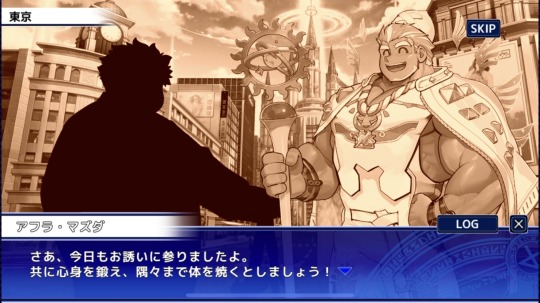
Back to the present with MC vs Ahura. Ahura’s Sacred Artifact shines brightly as if to illuminate this world. Ahura tells MC that his rule is to change anything other than what I was born with into light and make it manifest. Not only physical things such as clothing, but also wounds and illnesses. It is the power given to him to conduct the final judgment as the Supreme Judge. Now, his current role is that as an ally of the Entertainers. His mission is to stop MC without letting them die. They already settled things once before in the previous loop, so there’s no way MC can beat them. All their friends and ally are in the “backstage” now. Ahura tells MC that they will wait here with him until the next stage for the Entertainers is ready. We cut to Maria in the other dimension. She wonders if the others are safe. Then Nyarl shows up to show her an illusion of the original Maria. We then cut to the Game Master with Alice. She’s waiting for a certain person to show up. Sanat enters thanking her for answering his calls. Alice ask him where has he been. The Entertainers have gone out of control. Sanat saids he’s been looking into that. The first step is to look at their motive. Sanat ask her why does she participate in this game. Alice ask him what does he mean by that. Those who participate in this "game" have their own motives depending on their position. The world reps participate in order to obtain the “trophy”. But they, the Game Masters, don't have such external rewards. Continuing the "role" of the game master itself can be said to be a "reward". To keep this dream city alive and “Never grow old” is their shared purpose. As long as they continue to realize this eternal "game", they will never grow old. On the other hand, another guild on the management side, that Entertainers are the opposite. They exist to make the real city of Tokyo "like a dream". Make the "game" fun for the audience to watch. That is the condition and constraint on which they receive the reward. As long as they live in fiction, they will never grow old in this city. Wearing a mask, imposing reality on someone's role, living in fiction, that's how they live. Conversely, if someone else observes your “real self” as you are, you will grow older by that amount. If someone sees you, either kill them or you will have no choice but to accept it, like another half of you. The Entertainers exists to entertain the audience. This audience, i.e. those who do not participate in the game. A non-participant who does not have a “role” related to the game aren’t concerned about trophy. They just watch, that's the constraint and condition of being a spectator. Before the incident in Yurakucho this time, it was that Solomon and his terminal. The Entertainer were allowed to use its management privilege of “putting on and taking off roles” only to entertain those spectators. But if that's the case, there is one thing that just doesn't make sense. The first incident where a body part was left behind in Shinjuku, which was considered to be the origin of the current incident. Considering various circumstances, it can be said that it is clear that the Entertainers were involved in it. There is no doubt that the Entertainers used its management rights to start that incident in Shinjuku. But the next question here is, “Why was the Entertainers involved in it?” Who were the spectators of the event? Was it really just to "entertain the audience"? The Entertainers are hiding something serious and it probably violates this Tokyo 'game', and the identity at its core.

Back to MC vs Ahura. MC feels like he can’t win. Ahura tells him that’s because as long as he is the ally of justice and MC is its enemy, MC can’t win. Ahura tells them that he won't let them go. That's his mission as an ally of the Entertainers. But in the meantime, Ahura wants to talk to MC about one thing. Ahura begins to tell MC a story. In this world, there is no such thing as "absolute evil" for all living beings. Do you know what a judge's job is like? Universal justice is never an issue before the courts. There are 99 judges, 50 agree and 49 disagree, and their job is to judge such disputes. "The greatest happiness of the greatest number". It is the judge's job to manifest it in the world. Not automatically, but intentionally and responsibly. Truth be told, "dismiss the minority side." There can be only one thing in this world, such as "things that are evil from everyone's point of view." And Ahura saw the Entertainers on the side of justice. We cut to Oscar and Loki, who are watching the fight. Oscar wondered what would happen next but it seems like they will have to wait until the next stage is ready for them. They don't want their stage to be ruined anymore by amateurs who don't have a role, right? Ahura is a world representative, he should never be defeated by MC. Loki chuckles and said “maybe, but don't you think you've got something to lose, Oscar?” Oscar ask him “What did you say?” We cut back to outside to see Nobumichi making his report to Ahura. Nobumichi said he found a lot of criminal evidences in the opera house basement. Ahura thinks back to what Loki said to him. Ahura said I said, he’s an ally of the Entertainers, however, he is also an "ally of justice", so it’s fair, right? Ahura Mazda suddenly stopped moving. It's was like realizing that a slow-acting poison has passed through his body. Suddenly Q’ursha, who managed to escape, appeared to assist MC. Battle start!

After the battle, Q’ursha tells MC to grab on to him right as they are about to jump high. We cut to Oscar who asking why isn’t Ahura moving. Loki laughs at him and said he likes that panicked voice. It's a pity that he can't take off his mask because of his bondage. Loki ask him don't you think it's fair. "This world is a stage, and everyone is an actor"? Then, it's not fair that Oscar the only one who decides to watch from a distance. Loki want to see the destruction of everyone in this world. That's why he’s really looking forward to seeing Oscar’s destruction. He’ll prophesy it with his tongue. Oscar, your doom comes with judgment. Loki will watch over the show until the very end. We cut to the sky with Q’ursha and MC, their target is the base where Oscar is hiding. Back to Loki. Loki tells Oscar his doom is coming, what’s he going to do. Just then, Q’ursha and MC crashed through the roof and landed in front of Oscar.

19 notes
·
View notes
Text
Vayu, the warrior god of wind
I kind of wanted to fit something about the Iranic Mairiia into my Dracula article in order to discuss the worship of warlike gods as bart of a discussion of the barbarian in relation to Paganism, and then I ran into some fun ideas about Vayu, and Indo-Iranian god of wind who was also one of the warlike deities that were worshipped by the Mairiia.
To start with, let's reintroduce the subject of the Mairiia warriors, via "Anahita: A History and Reception of the Iranian Water Goddess" by Manya Saadi-nejad (2021; p.113-114).

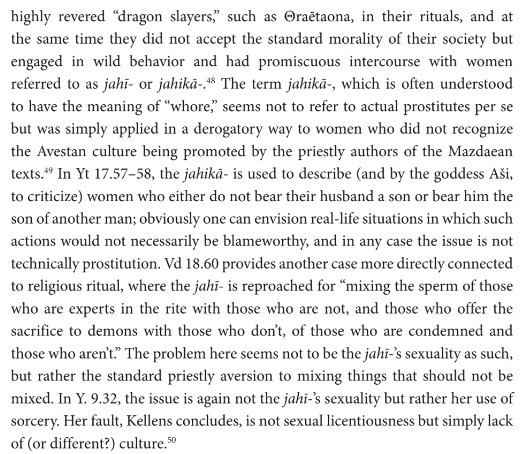

Vaiiu here seems like an Iranian name for both the wind and a complicated character of within Zoroastrianism, perhaps the Iranic form of the Indian Vayu. On the one hand he may have been perceived as a daeva, or at least had daevic characterisitics. On the other hand, he may have received the veneration of a yazata. One of the Yashts, the Ram Yasht, is devoted to Vayu. Here Vayu is honored, is the recipient of sacrifice, and appears to Zarathustra as the one who puts the spirits of good and evil in their place and spans both worlds.
In "Witches, Whores, and Sorcerers: The Concept of Evil in Early Iran" (2011; p.155-156), S. K. Mendoza Forrest discusses another aspect of Vayu: his identity as a warrior.

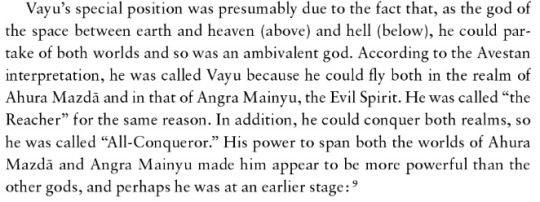
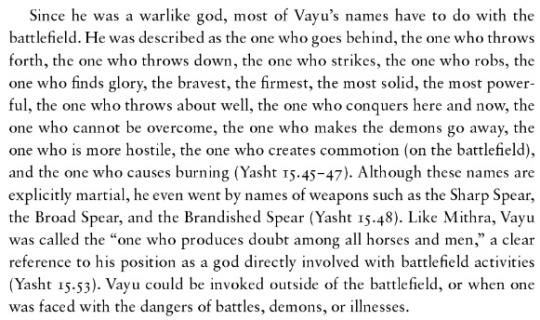
Forrest notes that Vayu does share multiple epithets with Ahura Mazda, but while Ahura Mazda was regarded as a moderately-tempered creator who could also be invoked against supernatural threats, Vayu was seen as a warrior god who could be invoked in war against enemies in battle.
Back to "Anahita: A History and Reception of the Iranian Water Goddess" by Manya Saadi-nejad (2021; p.59), we also see that Vaiiu, alongside Anahita, was believed to be worshipped by some of the villains of the Avestan narrative, including Franrasyan and even Azhi Dahaka.
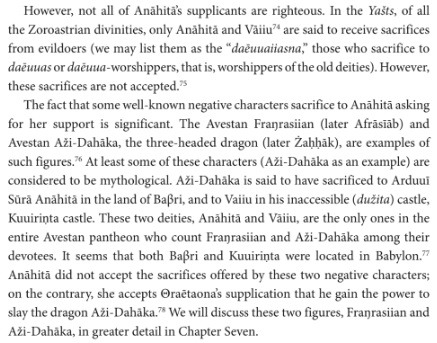
"Mairiia", in the Avestan context, was a word sometimes to refer to these villains (p.59-60), and also as a demonic/negative adjective for "young man". Their villainy also connected to the practice of older pre-Avestan Iranic rites that involved nocturnal (chthonic) sacrifices.

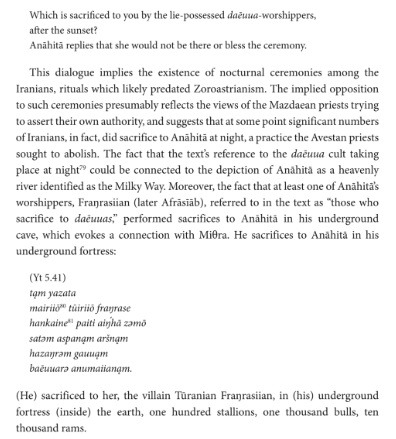
Vayu's warrior god status could in some way be seen, perhaps ironically, as an echo of his worship by the Mairiia as one of a number of warlike (in this context) deities, and thus an echo of older pre-Avestan tradition within the wider of body of Zoroastrianism. This aspect appears to be particularly connected to the Iranian worship of Vayu, and is less recognizable in the context of Hinduism. However, it is possible that Indra, the leader of the Devas, may have inherited warlike characteristics previously associated with Vayu.
According to Georges Dumezil in "The Destiny of the Warrior" (p.73), Vayu had an original function as warrior until later, when Indra rose to prominence in the Vedic pantheon and Vayu's warrior aspect was transferred to either Indra or Bhima, the latter a son of Vayu.
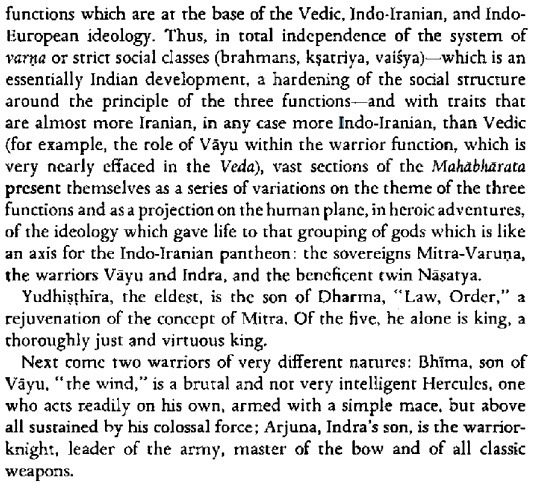
Later in the same book (p.90), Dumezil asserts that there are two kinds of war god in the Rig Veda: one represented by Vayu, the other by Indra.
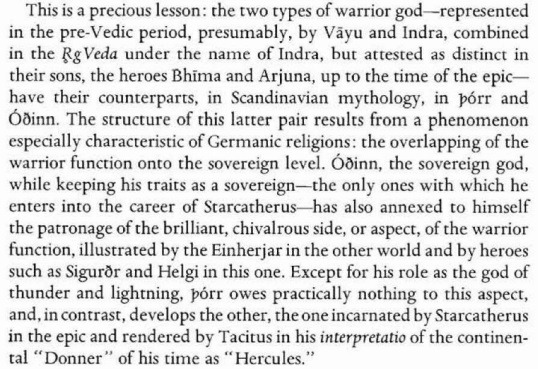
I suppose some small aspect of this must be reflected in his appearance in Japanese Buddhism as Futen, not to be confused with Fujin. Futen appears as an old man in the garb of a military general, and is counted as a member of a group of deities collectively referred to as the Twelve Devas, or Juniten. In Japanese art, the devas (referred to as "Ten" in Japanese) are often depicted similarly wearing the garb of military generals or simply brandishing weapons. These include not only members of the Juniten but also the Shitenno, the Four Heavenly Kings.
So, all in all, Vayu, though popularly remembered mostly as a god of wind, also has a legacy as a warrior god, and perhaps that legacy still persists.
#barbarians#mairiia#paganism#warrior gods#war gods#polytheism#hinduism#zoroastrianism#japanese buddhism#devas#vayu
13 notes
·
View notes
Text

OH BOY so there are some wacky shenanigans with the full family tree on this one. To make the poll doable I had to par this down to just those with direct ties to the core monster family in question (so no retroactive or 2nd degree ties included this time)
TATZELWURM, originally butchered by localization as "Tatzelbelm" shares a model with 2 other monsters in WA1: SALAMANDRA and BUBBLE TORTOISE(we'll get to them...) And the real world Tatzelwurm is a mythic creature from the regions around the Swiss Alps said to have the body of a serpent and the head of a cat, said to lurk about mines, hissing and causing poisoning. It's possible they're actually just an explanation for gas leaks.
the WA2 TATZELWURM shares its model with GILA MONSTER, which is the common name of the Heloderma suspectum, a venomous lizard local to the Sonoran desert. Growing up around the Sonoran Desert as a kid I remember being told that if a Gila Monster ever bit you, the only way to get them to let go would be to cut their head off, as they'd stay latched on even after death otherwise. I don't think that was true. And speaking of myths about the Gila Monster, funny enough old settlers used to believe it had poison breath, so it being a recolor of the Tatzelwurm is actually quite appropriate.
in WA3 the TATZELWURM is redesigned from scratch again into a broadheaded and horned drake-like creature and shares this model with JABBERWOCK and MUSHUSSU. JABBERWOCK was originally a recolor of HYDRA in WA1 and misromanized as "JAVAWALK." It is of course the subject of the famous C.S. Lewis poem of the same name, with a notable cameo in Through the Looking-Glass entrenching it in popular culture as part of Alice in Wonderland lore.
MUSHUSSU utilizes a strange model in WA2, shared with JABBERWOCK and FOUNDER LIZARD(localized as "JACK LIZARD" for some reason...) I believe MUSHUSSU is the core member of this family because of how the mythological creature is described: "a scaly animal with hind legs resembling the talons of an eagle, lion-like forelimbs, a long neck and tail, two horns on it's head, a snake-like tongue, and a crest." But it becomes a recolor of Tatzelwurm in WA3. (Funny enough JABBERWOCK and MUSHUSSU share both their WA2 and WA3 models.)
SALAMANDRA is a red (and weirdly fleshtone?) recolor of the original TATZELWURM that branches off in subsequent games. It being the mythic and alchemic Salamander, it is of course strongly associated with the element of fire. Despite some dramatic changes, it does actually loop back around to being a TATZELWURM recolor in Alter Code F.
BASILISK shares SALAMANDRA's model in WA2. It has kind of a complicated family tree itself, that we won't get into here, but notably it shares a model with COCKATRICE and BLACK SABBATH in WA1, and ALLIGATIGER and CHIMERA GEO in WA3.
And in WA3, SALAMANDRA also shares a model with both HYDRA and ZAHHAK. The character model in question seems to originate with HYDRA's redesign for WA2 which features prominently in the disc 2 OP. I assume we all know the mythic Hydra.
But ZAHHAK is perhaps a little more obscure a pull for a JRPG in the 90s. It refers to the villainous figure of Persian mythology, Zahhak The Dragon, aka Zahhak the Snake Shoulder, aka Azi Dahaka. So the idea of "Snake Shoulders" being represented in the HYDRA model's many heads is appropriate. And as it happens in Wild Arms 5 there is a monster AZI DAHAKA which actually comes in like 6 different forms, it's a whole thing... but I can't even find any good screenshots of it anyway.
and finally last and absolutely least in this family tree, BUBBLE TORTOISE, localized as just "Tortoise" is a light blue recolor of the original TATZELWURM that never came back after the first game.


2 notes
·
View notes
Text


Rave Master Vol 18
#inu's bday jams#rave master#the groove adventure rave#hiro mashima#Let Dahaka#haru glory#Hamrio Musica#rm elie#fantasy#adventure#manga#tw: nudity
9 notes
·
View notes
Text
Shahid's combat title is the name of one of many places in Iran. What.
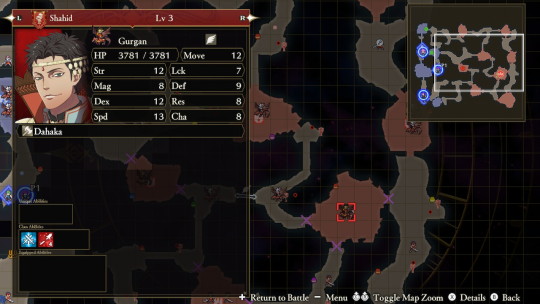
The most common reference to Gurgan, Iran. One definition includes a defensive wall. Maybe they thought of that Gurgan instead? It'd fit a bit better thematically, anyway. Still very silly though.
At least the Dahaka axe is named after an Iranian mythological creature - an evil one to boot.
The bonus is that Zahhak/Dahaka is a draconic creature. Hmmmm
Prolly no thoughts on the dev's part, let's be real here.
#fire emblem three hopes#shahid fire emblem#golden wildfire#fe3h meta#thotz#iranian mythology and stuff
15 notes
·
View notes
Text

Java Let Dahaka
will never recover from this manga… so good!
#let dahaka#Let#rave master#hiro mashima#my first post#my artwork#sketch#ibispaint art#anime manga#manga#anime fanart#anime art#anime guy#anime men
8 notes
·
View notes
Note
Kyoya gaen for bingo!
thank you for sending in 🙏💕🤗
That’s a solid design right there
They are SO SILLy
if anything happens to them I will cry
I’m not sure if I’ve talked about this here before but I heavily headcanon Kyoya as having a complex about his short height.
His chair legs in Canon seem to be specially constructed because his tiny legs REaCH the floor in them! All his chairs, from the organ chair to his throne chair in the Gaen Cup to the one he sits in at home. And the fact that he always stands on top of a staircase to address disaster? 👀👀 so that’s the silly part.
he’s heavily drawn upon from the Bible, due to his connections with Azi Dahaka. Now please let me draw your attention to the episode in ddd where Azi Dahaka comes out from the sea, and the infamous iceberg incident where Azi is lurking beneath the ship. In the Bible, Revelations chapter, the writer specifically mentions a red dragon living in the sea who is the very embodiment of evil….this is very consistent with the messiah concept ascribed to Kyoya by the usage of his cross accessory (he’s trying to become God and overthrow destiny, sort of like Satan who tried to defeat God and take his place…), as well as Tasuku. I have mentioned this in an earlier post, that Tasuku seems to be playing a warped version of a holy crusader in Kyoya’s ‘Holy War’.
well played, well constructed Bushiroad. well played.
he’s so so aware of all the evil things he’s done BUT although he may pretend that it’s for good, his logic and ideals are basically communism. That’s why he later repented.
I love hyperfixating on his warped ideals but don’t exactly care for him as a person? Because he is inexcusable and throughly arrogant….but if anything happened to him Rouga would cry and that would make me cry 😭
#Answerred#Thank chuuu for the ask#I’m a Christian so the biblical stuff is second nature to me I’m sorry if I made it confusing#Kyoya gaen#hyperfixation#future card buddyfight#rant
1 note
·
View note
Text
A Review of Prince of Persia: Warrior Within
The Bloody Mary of the Franchise
Yes, I often lie awake at night wondering how this game came to be. Imagine you’re some creative director at Ubisoft and Sands of Time just came out. It’s a commercial and critical success and you think to yourself: wow, let’s make a sequel.
The game you just created could serve as a strong foundation for an upcoming franchise. Stories set in the Middle East are a rare treat and you’ve barely scratched the surface. You established a complex and well-liked protagonist and it’s only natural to continue his journey. So where do we go next from maharaja’s palaces and the sound of Oriental music?
Enter Godsmack. Yes, Godsmack. I mean, if someone only played the prison sequence from SoT, I guess they might come to the conclusion the franchise was all about hard rock and bloody walls. For everyone else the shift in direction is seizure inducing.
From a cynic’s point of view none of this is surprising. It’s a dumb corporate move to cash in on the recent success, while also fixing the issues of the first game and making it more mature (and let’s interpret maturity as more blood and nudity while we’re at it). You know what is surprising? It’s that this game actually turned out good.
It’s crazy to think that Warrior Within came out only a year after Sands of Time was released. Even back in the day, when games were smaller, this was insane. You’ll realize the two games share the same DNA as soon as you pick up the wooden branch in WW’s first level. A keen ear will notice that hitting a rock with it will produce the same metallic sound effect it does in SoT when you hit a wall with your sword. I’d normally call this an absurd oversight, but in a game which suffers from an identity crisis hearing the old sound effects helps ground WW within the same franchise.

Watch me beat the Dahaka with this piece of wood.
The Holy Trinity which SoT was composed of were the story, the platforming and the combat. What’s interesting is that each of these aspects got handled differently in WW. The story (which I’ll couple with the presentation) experienced a full 180, the platforming remained the same and the combat was added onto like toppings are layered over a waffle. Let’s break each one of them down starting from the story.
Coming back to WW after some time, I was worried I’d find the game’s edginess a bit juvenile. I first played WW when I was a kid and the Prince’s acts of defiance always resonated with my own refusals to do my homework or clean my room. A part of my concerns proved to be justified, but for the most part I was surprised to see that the game is a lot cooler than I ever gave it credit for. The moment that intro hits you and the Prince stands up to the Dahaka with his swords up, you know the game means business. I think that despite the tacky rock music, the over-saturated blood effects and the fact that the Prince sounds more like Kratos than a posh Brit, the game still manages to resonate because of its strong emotional core.
The story picks up a couple of years after SoT, with the Prince being chased by death itself, the Dahaka. Most games try to convey the characters’ emotional struggles through cut-scenes, but WW does it right through gameplay. You know exactly what drove the Prince to fight for survival like a cornered animal because you’re forced to fight for survival throughout the entire game. The enemies are blood thirsty, the traps are unforgiving and the Dahaka is constantly breathing down your neck. You have to become a savage to get through this game and there’s no wonder there’s nothing left of the naive youth we got to know in SoT. Nowadays I wouldn’t be caught dead listening to Godsmack, but no other music better reflects the despair and rage which fuels the Prince in battle.
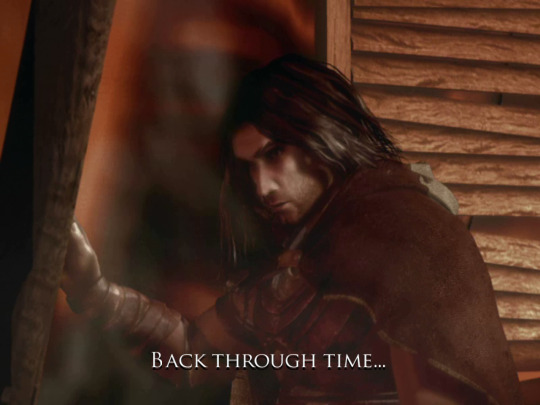
If I could turn back time...
In a lot of ways WW’s story is more than the sum of its parts, but there are parts that still stick out. First off, the women in this game are absolutely ridiculous. I don’t know who’s worse: the metal thong pirate or the empress with her vague Italian accent (totally not a stand-in for Monica Bellucci). Kaileena sort of has an arc, but I just can’t take Shahdee seriously. Some of the game’s attempts to sound more mature, like the Prince calling Shahdee a bitch, just made be burst into laughter.
Likewise, the time travel in SoT required some suspension of disbelief, but in WW that is stretched to the maximum. The game has no idea if cause and effect apply to any of its scenarios, let alone how to make sense of the convoluted plot. The Mask of the Wraith is a shameless MacGuffin and if it weren’t for the emotional pay off in the end, the whole plot would just cave in.
The pre-rendered cut-scenes still look sick by today’s standards and are probably the main source of inspiration for the mountains of fan art dedicated to the game. On the contrary, the in-game ones are hilariously clumsy. The dialogue is wooden and awkward and the cuts are often unexpected and jarring. Thankfully the story is told through more than just cut-scenes. While I’ll always hold SoT as the superior game, there is one aspect of WW which surpasses its predecessor and that’s the level design.
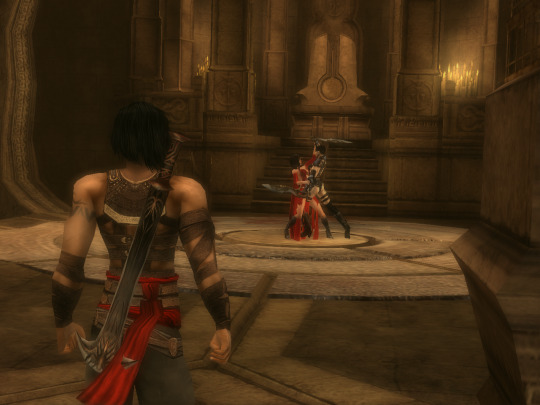
I think I'm just gonna stand back and let you ladies settle your differences.
Don’t get me wrong. I think SoT’s level design is superb. Each level was beautiful and instantly memorable. The platforming sequences were masterfully laid out to allow for exciting combos and each level told a unique story of this once mesmerizing, but now devastated palace. While in SoT the levels were stringed together and after completing one you’d move straight onto the other, in WW everything is connected. The Island of Time feels like a living breathing ecosystem which you get to explore in a significantly less linear fashion.
I simply adore the idea of jumping between the past and the present and experiencing the levels in different ways. I feel WW got the chance to be a lot more contemplative with the design of its obstacles. Observing a room and how it used to operate in the past and then witnessing the way it fell apart in the present gives the world of WW a whole new dimension. The levels don’t only play, but also feel different. The past makes you an intruder in this alien world of ancient mystery and the present cruelly reminds you of the imminent doom that awaits both you and the Island of Time.
I’m amazed at how confidently the game lets you retread levels. The moment that really impressed me was when I missed the health upgrade in Shahdee’s boss room. I decided to try to go back for it much later and was surprised that the game actually let me do it. It had to account for both the ruined staircase leading up to the boss room and the collapsed hallways from a previous Dahaka chase, yet it still put in the effort. This immense sense of inter-connectivity becomes even greater once you put on the Mask of the Wraith. That’s when the game takes you by the hand and leads you behind the curtains of each level.
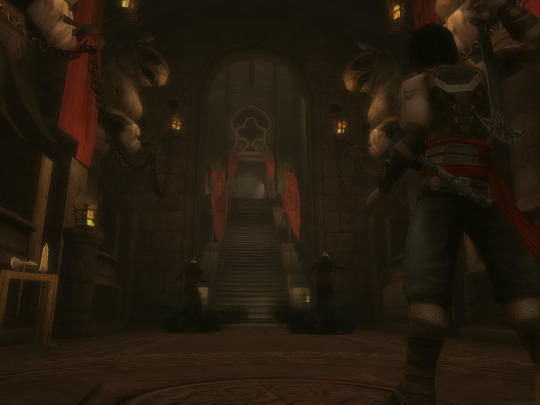
Welcome to the Island of Time! The throne room is up ahead, lavatories to the left.
This strange world is presented in much different colors than the ones you found in SoT. Gone are the bright yellows and calming blues of the Orient, replaced by murky greys and browns and lots and lots of red. The contrast within the palette is nothing revolutionary, but it does the trick. Inside combat music fiercely pounds in your ears and blood sprays from each enemy you slay. Outside of combat more melancholic tracks accompany your exploration of the ruined citadel and the slow sinister darkening of your screen signals the dreaded arrival of the Dahaka. The atmosphere couldn’t be more oppressive, yet the environments are still as captivating as ever.
The one thing that fell pray to the game’s art style is the visibility of its obstacles. WW’s palette is pretty bleak and while I get this is brought on by the themes of the game, I don’t think you should let your art style degrade your gameplay. Some things like the red drapes are properly accentuated, but I often died or got stuck because the next ledge or beam just didn’t pop out of the background. The bird’s eye and first person view don’t help much and potentially exhilarating sequences are transformed into guess work.
But none of this excellent level design could be appreciated if traversing the world of WW wasn’t satisfying, which gives me a great segue to talk about the platforming in the game. As I mentioned earlier, WW imports SoT’s platforming mechanics. Instead of modifying them, it just utilized them even more. While SoT’s platforming sequences could be challenging, WW really pushes the limit putting all of your skills to the test.
There are new traps along with the old ones - the ropes and the extruding blocks being the first to come to mind. But new obstacles aren’t the sole reason why the platforming is so good in the sequel. The first reason are the later parts of the game when you put on the Mask of the Wraith. This is when the platforming sequences becoming devilishly difficult and would be frustrating if it weren’t for the regenerating sand tanks. I felt that some of the ideas presented in these sequences, like the tilted walls you had to jump off, had enormous amounts of potential.
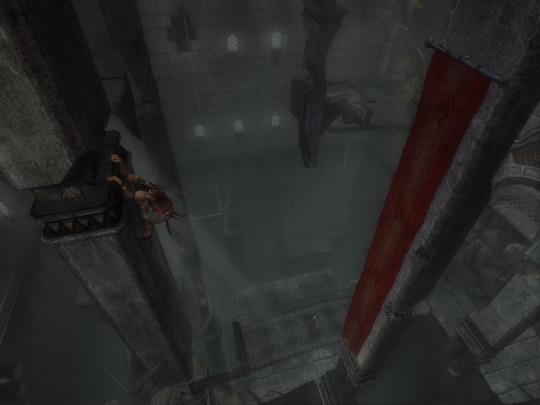
Some poor chump is putting in the effort to wash the curtains even after the plaster has fallen off.
The second reason, and you’ve guessed it, are the Dahaka chase sequences. In WW the Dahaka is the main driver of the plot. It’s the main source of tension and the reason behind the Prince’s emotional state. Usually games let you fight your antagonist, but I think it’s so much more effective that the only thing you can do against the Dahaka is run. Each time you travel back to the present, there’s a looming fear of when the beast will appear next and each time it does, your adrenaline spikes through the roof. Not only that, but the Dahaka puts all of your platforming skills to the test. You’re asked to perform the same stunts you practiced earlier in the game, but this time with flawless precision and no time left to spare on the clock.
As much as I praise the Dahaka’s every appearance, the final boss fight against it is abysmal. The worst kind of difficulty is the one that’s a product of bad game design and you could easily fill a bingo card with just this fight. A good boss builds up on all of the skills you’ve learnt so far, but none of the advanced combos or techniques you’ve been perfecting during the game are viable against the Dahaka. Its attacks aren’t properly telegraphed, your dodges don’t provide consistent iframes and you can’t block or counter-attack it. The only option you have is to spam roll + attack until your fingers give out or you’ve chipped enough of its health bar to be able to finish it off with the Cyclones of Fate. It’s a test of your good will and patience and certainly not of any skill you've acquired while playing the game.
And here comes another perfect segue to talk about the final aspect of WW - the combat. You can tell that Ubisoft is proud of WW’s combat system since they called it something as stupid as “Free Form Fighting”. To put in plainly, Ubisoft decided to take SoT’s combat and use it as a foundation. On top of that foundation they build a house which is WW’s combo system.

Run, you fool!
The promo materials sure like to brag about all the possibilities this system has to offer and for the most part they are not exaggerating. The sheer amount of combos is impressive to say the least. I guess you could button smash your way through most fights, but the game is the most satisfying when you perform a deliberate set of actions and see heads flying as a result. Combos are broken down into categories and while its impossible to memorize all of them in a single playthrough, you’re sure to use a wide variety to get you through different encounters. The system offers a lot of room for creativity, so while you’ll perform a lavish move like the Angel Drop in one room, you might feel inclined to steal an enemies axe and chop its head off in another.
Having said all of that, while WW’s combat is its most marketed and talked about feature, I think it’s also one of the game’s most flawed elements. SoT’s combat was far from ideal and left a lot to be desired. However when deciding to use it as WW’s foundation, Ubisoft didn’t fix a single one of those issues before neatly stacking a combo tree on top of it. As a result the whole house is shaking.
One of SoT’s most critiqued features was its camera. It had a tendency to go bonkers whether that was in the platforming sections or in combat. SoT did some simple tricks to circumvent this. Mainly, the levels in that game are wide and spacious, not giving the camera many chances to get stuck on random objects.
Contrary to that, the Island of Time is a labyrinth of tightly weaved corridors which invites a whole new set of issues. More often then not you won’t be able to turn the camera because it’s smashing against one of the nearby walls. Getting it to do what you want is like trying to tame a stallion. The prime example of this are the golem fights where the camera’s main objective must have been to induce motion sickness.
The tight corridors also narrow your field of view, which spells disaster for a lot of the enemy encounters. The enemies are much more aggressive, so while in SoT you could just wait for them to come to you, in WW you constantly need to be on your guard. They’ll rush you from off screen without any prior indications and usually while you’re in the middle of performing another move. I’m having war movie flashbacks just thinking about the bloody hedgehog dogs.
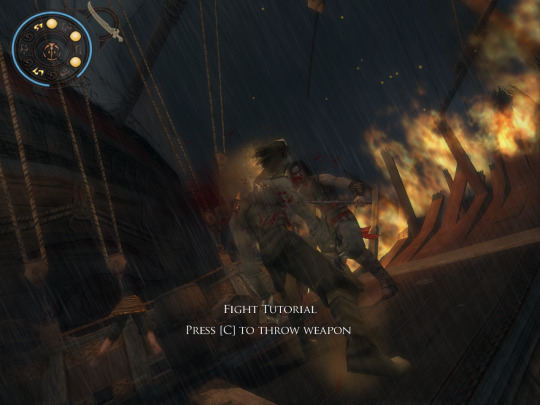
I almost regret the fixed camera angles from the tutorial section. Almost.
Speaking of combos, the biggest sin this game commits by far is not giving you any iframes during your finishers. This is such a huge and glaring misstep that I honestly don’t know how it made it into the final product. If I perform a complex button combination and initiate a high damage combo, shouldn’t I be rewarded for it? You could say that initiating a combo in the wrong moment should punish the player, but that’s not what I’m arguing against.
In WW you might assess the situation and determine that it’s the right time to perform a certain move. However while your in the combo’s animation the status quo can drastically change. I’d be fine with this if the game let you break out of combos, but once the animation starts rolling you’re stuck in it until the end. What’s worse is that some enemies can break you out of your own combos, even though you yourself don’t have that power. The assassin ladies are the worst since their jump attack can not only break you out of an animation, but also lock you in their own.
The hit boxes don’t abide to fairness either, so sometimes enemies can stand far enough not to be hit by you, but also somehow close enough to do damage to you with their own attacks. So while you’re stuck in an animation, some cheeky bastard could happily chip away at your health. Mix that in with enemies rushing you from off screen and you’ll soon find yourself smashing you head against the desk.
You could always play more defensive, but then what’s the point of the combo system? Shouldn’t you be encouraged to charge into crowds like a blood thirsty beast and unleash all hell around you? The promo materials show off all of these fancy moves, but outside the sterile testing environments fights can get extremely messy.

Which one of you smart asses would like to smack me over the head first?
I’d honestly like to attribute all of this to my shortcomings as a player, but having beat the game on the hardest difficulty multiple times I’m beginning to see a clear line over which my combat prowess gets subjected to chance. A game shouldn’t base its difficulty on unpredictable attacks and mechanical hiccups, but on mastering its systems and learning how to spot and take advantage of enemies’ weaknesses.
Environmental combos, while some of the best looking, aren’t the most joyous to perform either. Some of the controls for platforming and combat overlap and the game can have a hard time determining which action you want to perform. E.g. wall running and blocking occupy the same button, as well as attacking and doing stunts with pillars. It’s insanely annoying when there’s an enemy waiting for you on the other side of a pit and you can’t initiate a wall run because the Prince keeps blocking instead. Though I do love that you can swing your secondary weapon and wipe the smile of their face (die hedgehog dogs, die).
Having criticized the game’s combat so much, I have to admit that when the cards are just right WW can provide some of the most satisfying scrumptious carnage there is. Seeing your carefully executed moves in glorious slow motion, ending with an enemies last whimper, will leave you gloating every single time.
I also like that the game encourages you to use sand more often. In SoT, my tanks were usually half full, while in WW I was constantly begging for more. This is certainly the result of the higher difficulty, but I don’t condone it. However the game can get itself into trouble when it forgets to take into account your sand consumption. There are certain environmental obstacles which you can only overcome by slowing down time, but sometimes you’ll get to them with no sands left in your pockets. This wouldn’t be a problem if the game remembered to put one or two jars in the vicinity, which it doesn’t always do.

Buddy, you're done for.
On the technical side of things, I encountered some minor issues (though they might be exclusive to the Steam version). The save system is pretty buggy. After a reload, enemies that should be dead reappear and enemies that should be alive are nowhere to be found. The secondary weapon you’ve been carrying can disappear after death. This seems like a nitpick, but it’s especially aggravating when you’re fighting the Dahaka for the fifth time and need your Light Sword. The game can sometimes freeze during loading screens and you’ll have to close it by force. Also, skipping cut-scenes only works after you’ve seen them for the first time and the game completely forgets about this if you decide to reload your save or, God forbid, exit the game.
If I were to give one final note, it’s that Stuart Chatwood is probably the best investment Ubisoft made with the entire franchise. Lots of tracks in that game had a hint of hard rock and Chatwood masterfully flipped them inside-out to get what we now know as WW’s OST. You might have thought that the sound of WW is pure rock, but the Oriental roots of the franchise are interwoven with the guitar riffs in a lot more tracks than you’d think. It makes the two OSTs perfect mirror images.
Warrior Within is probably the best PoP game to bring up over a beer. It’s a game based on numerous contradictions and seeing how each of those manifested itself in the final product is fascinating. It was scrutinized upon launch, but amassed a cult status over the years and is now remarked as a diamond in the rough by many. Time took off my rose-tinted glasses and made me see Warrior Within as the flawed ride it truly is, but even so I’m taken aback each time I boot it. I know only a few games that take this many risks and even fewer that manage to pull it off this well.
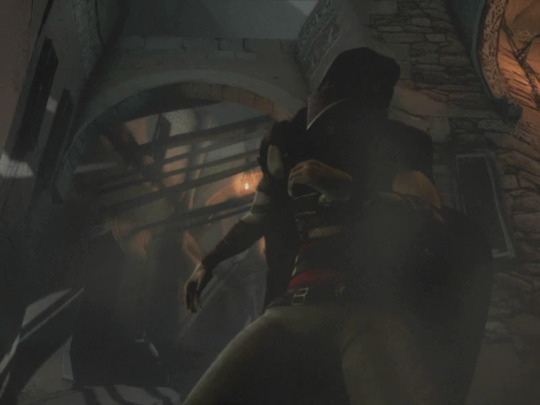
Right to retcon the sequel or left to cash in from the movie tie-in? Oh, man.
1 note
·
View note